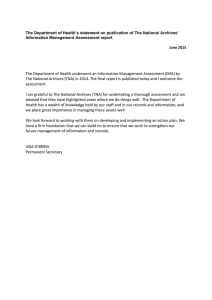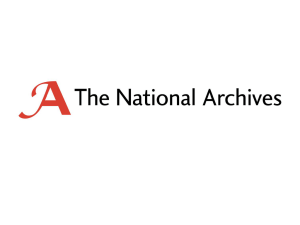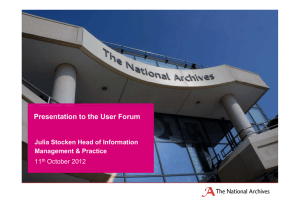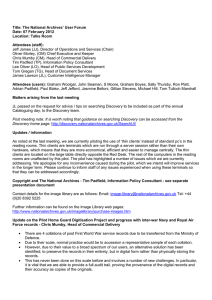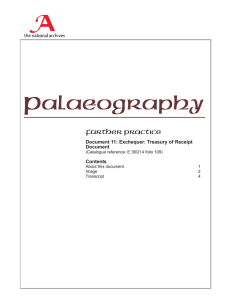Title: The National Archives’ User Forum Date: 11 October 2012 Attendees (staff):
advertisement
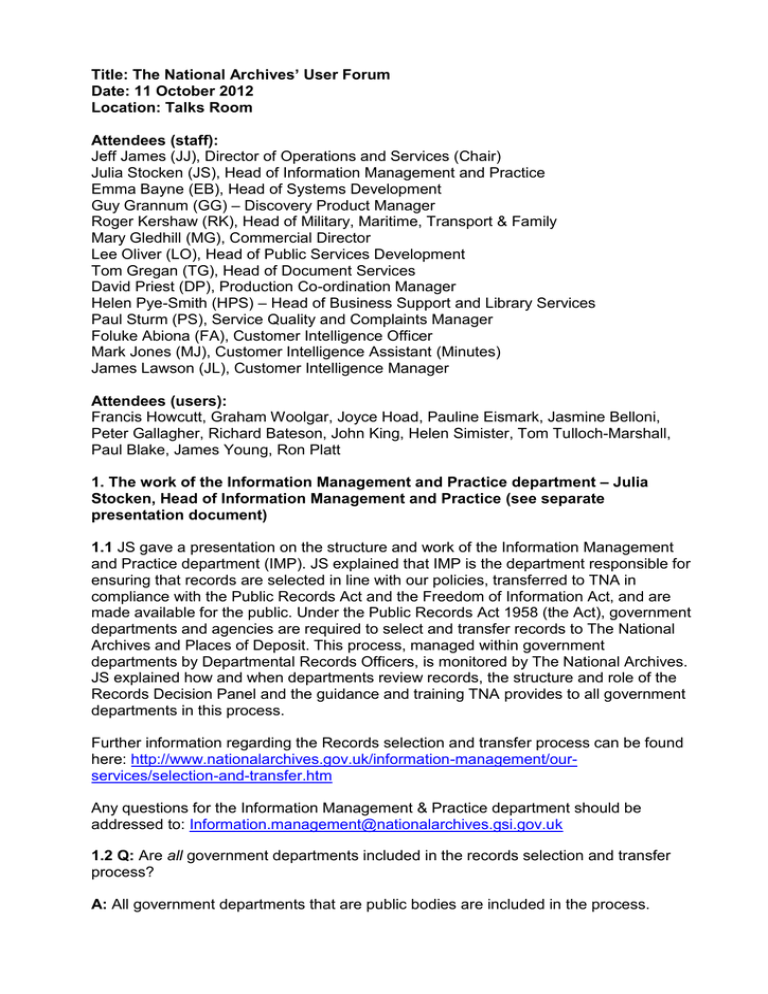
Title: The National Archives’ User Forum Date: 11 October 2012 Location: Talks Room Attendees (staff): Jeff James (JJ), Director of Operations and Services (Chair) Julia Stocken (JS), Head of Information Management and Practice Emma Bayne (EB), Head of Systems Development Guy Grannum (GG) – Discovery Product Manager Roger Kershaw (RK), Head of Military, Maritime, Transport & Family Mary Gledhill (MG), Commercial Director Lee Oliver (LO), Head of Public Services Development Tom Gregan (TG), Head of Document Services David Priest (DP), Production Co-ordination Manager Helen Pye-Smith (HPS) – Head of Business Support and Library Services Paul Sturm (PS), Service Quality and Complaints Manager Foluke Abiona (FA), Customer Intelligence Officer Mark Jones (MJ), Customer Intelligence Assistant (Minutes) James Lawson (JL), Customer Intelligence Manager Attendees (users): Francis Howcutt, Graham Woolgar, Joyce Hoad, Pauline Eismark, Jasmine Belloni, Peter Gallagher, Richard Bateson, John King, Helen Simister, Tom Tulloch-Marshall, Paul Blake, James Young, Ron Platt 1. The work of the Information Management and Practice department – Julia Stocken, Head of Information Management and Practice (see separate presentation document) 1.1 JS gave a presentation on the structure and work of the Information Management and Practice department (IMP). JS explained that IMP is the department responsible for ensuring that records are selected in line with our policies, transferred to TNA in compliance with the Public Records Act and the Freedom of Information Act, and are made available for the public. Under the Public Records Act 1958 (the Act), government departments and agencies are required to select and transfer records to The National Archives and Places of Deposit. This process, managed within government departments by Departmental Records Officers, is monitored by The National Archives. JS explained how and when departments review records, the structure and role of the Records Decision Panel and the guidance and training TNA provides to all government departments in this process. Further information regarding the Records selection and transfer process can be found here: http://www.nationalarchives.gov.uk/information-management/ourservices/selection-and-transfer.htm Any questions for the Information Management & Practice department should be addressed to: Information.management@nationalarchives.gsi.gov.uk 1.2 Q: Are all government departments included in the records selection and transfer process? A: All government departments that are public bodies are included in the process. 1.3 Q: Are security services included in the process? A: Security services are not obliged to be a part of the process as they are subject to an exemption under the act. However, they do voluntarily transfer many of their records. 1.4 Q: When a document is redacted what happens to the information that is removed? A: The part of the document that is removed remains closed for a given period after which its closure status is reviewed. 1.5 Q: You have stated that the re-closure of records is undertaken in accordance with section 5(3) of the Public Records Act, but 5(3) doesn‟t explicitly refer to re-closure. Please could you clarify? A: We will check this and get back to you. 2. Discovery update and feedback session – Emma Bayne, Head of Systems Development 2.1 EB provided an update on the recent improvements to the Discovery service including an outline of the new browse function for both hierarchy and reference. EB also advised the User Forum that DocumentsOnline has now been closed and that we are currently in the process of gathering the final feedback before the proposed closure of the old online Catalogue. EB invited questions and feedback on Discovery from the User Forum. 2.2 Q: Was DocumentsOnline closed without any consultation process? A: No. DocumentsOnline was closed in accordance with the strict criteria that had to be met in the development process of the Discovery product. There was extensive consultation and its closure was deferred on at least two occasions while Discovery was still being developed. 2.3 Q: When was DocumentsOnline integrated into Discovery and how did we inform people that this had been done? A: A news item announcing the closure of DocumentsOnline appeared on The National Archives‟ website on 30th September. We've integrated the digital document delivery service provided by DocumentsOnline into Discovery, making it easier for users to search our records and download digital copies (where available), all in one place. Discovery also features an image viewer, which means that users can see a lowresolution version of a document before paying to download it. 2.4 Q: I have noticed that when I use the advanced search function on the Discovery catalogue and the search fails it automatically returns me to the general search function on the front page. Shouldn‟t it return you back to advanced search? A: We will investigate this. 2.5 Q: Why does Discovery return no results one day and lots of results on another day when I do exactly the same search? A: Discovery is constantly being updated so the information that was returned when you did the search for the second time may not have been there to be found the first time you tried. 2.6 Q: The „order now‟ function seems to be missing from Discovery for certain documents. Why is this? A: We will investigate this. 2.7 Q: When I tried to browse HO 45/16952 by reference the results were displayed in a completely random order. Why is this? A: We are aware of this issue. The information on Discovery is drawn directly from the old online Catalogue and the result would be the same in both catalogues. Discovery needs to be updated and reordered in this instance and we are looking into this. 2.8 Q: When I searched the name of a place or a surname on DocumentsOnline the results were returned in date order. The way search results are displayed on Discovery takes up a lot of screen space and are not displayed in date order. Can anything be done about this? A: By clicking on the „simple view‟ function this will reduce the amount of screen space taken up by removing the detail from the result and only displaying the title, date range and document reference number. We will look into the query regarding documents not being returned in date order. Please send your feedback to discovery@nationalarchives.gsi.gov.uk which will be added to the issues log for investigation and consideration. 3. Red lists project update – Roger Kershaw, Head of Military, Maritime, Transport and Family 3.1 RK provided an update on where we are with regards to the availability of paper lists in the Research Enquiries Room (the “red” lists). RK began by giving a summary of the background and explained that usage surveys had now been undertaken along with extensive analysis of document ordering and other document related data as well as consultation with key Record Specialists. RK then outlined the proposed methodology for the gradual removal of selected Red Lists (i.e. lists with fewer than 100 descriptions and where productions have not exceeded 20 in the past 12 months, as well as fully digitised series with new metadata, and wholly re-catalogued series) which will commence from January 2013 and will include a deliberate period of feedback and reflection in May 2013. 3.2 Q: How will people be informed which series have been removed? A: A „dummy sheet‟ will appear in place of any list that has been removed from the Research Enquiries Room and the project timetable will be published on the website. 3.3 Q: I regularly use the red lists for looking up document references for Treasury documents as I find searching on the computer takes too much time. Will these lists be removed? A: No. The total number of piece descriptions in the main Treasury series exceeds 100 so they will not be removed. 3.4 Q: What will be the cost of carrying out the removal of the paper lists? Will it impact on resources? A: We do not anticipate that the removal of the paper lists will have any significant impact on resources. However, we will review any impact it is having in May 2013. 3.5 Q: What I find particularly useful about the paper lists is that they provide me with the former reference number for particular documents (e.g. AIR 16). The former reference number is never shown on the old Catalogue or Discovery. What can be done about this? A: The removal of the red lists does not mean that they will be destroyed. They will remain onsite and we will be putting in place a procedure for readers to order the red lists that are no longer available in the Research & Enquiries Room. However, we will look into whether Discovery can be updated to include any information, such as former reference numbers, which currently only appears in the paper lists. 4. Matters arising from the last meeting 4.1 Q: Will it be possible for the next User Forum meeting to commence slightly earlier at 17:00, as there is likely to be a lot to get through when reviewing actions from a years worth of meetings? A: Yes, we had already discussed this internally due to a request made at the last meeting. The next User Forum meeting will be dedicated to „mopping up‟ any outstanding issues from previous meetings. This will include a discussion about the distinction between the User Forum and User Advisory Group and the effectiveness of the two fora. We will distribute a list of actions from the year‟s meetings, indicating where we feel that a particular item has not been fully closed. Users are invited to identify any additional items they wish to be included in this discussion and inform James Lawson in advance of the meeting. The agenda will be published two weeks prior to the meeting. 4.2 Q: Please can you update us on when the Second World War Navy and Air Force service records will be made available? This question has been repeatedly asked and we have still yet to be given a satisfactory answer. A: This is proving to be a very complex issue and as confidential discussions with third parties are still ongoing we are sorry to report that we are still not in a position to answer this question at this time. We will report back as soon as we can. 4.3 Q: I have noticed that the digital database of „Soldiers who Died in WW1‟ is no longer available at TNA. Why is this? A: Yes, that is correct; the CD version has been removed. It has been replaced with a link to the same database on Ancestry. We apologise for the rather sudden removal of this application but the CD has stopped working. The Commonwealth War Graves website provides a similar memorial scroll to that on the „Soldiers who Died in WW1‟ CD-ROM and can be accessed here: http://www.cwgc.org/find-war-dead.aspx The National Burial Index on CD-Rom is also no longer available for the same reasons; a link to the burials information on Ancestry has been provided instead. The usage of CD-ROMs is very low at TNA and we are in the process of replacing OPERA (which is now very outdated) with an alternative system for accessing online resources. The new system will not include a provision for CD-ROMs which are becoming increasingly outmoded and costly to support. HPS reported to the User Advisory Group on our proposal for updating the provision of onsite electronic access to publications from our reading rooms in September and a handout from that meeting can be found here: http://www.nationalarchives.gov.uk/getinvolved/uag-meeting-notes.htm 5. Date of next meeting: Thursday 8th November 17:00-18:45
